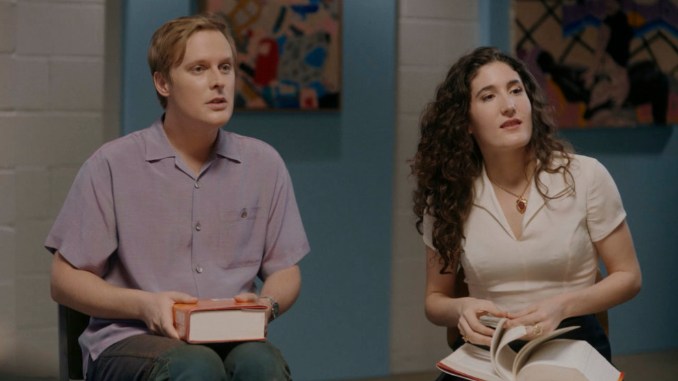How Would It Kill You To Laugh? and Inside Create a Full Picture of Millennial Anxiety
Image courtesy of Peacock
On the surface, John Early and Kate Berlant’s new special, Would It Kill You To Laugh?, seems like it would be the polar opposite of Bo Burnham’s 2021 project, Inside. The former is a highly produced sketch special about two best friends (and later enemies) and the latter is a solo special created by, produced by, and starring one person in a room by himself. Yet despite their differences, they feel inherently linked, tied together by a specific brand of millennial anxiety that is shared by their creators. They exist as companion pieces for audiences who feel overwhelmed by being alone, and overwhelmed by being around others.
In the world of Would It Kill You To Laugh?, John Early and Kate Berlant are a world-famous comedy duo who had a messy falling out and are coming back together to reconcile. The special is framed around an interview with the pair, and it’s clear that other people’s opinions (and the weight they have on Berlant and Early) are a driving force of the piece. During a book club sketch, they try to waffle their way through a conversation about a book they haven’t read, but are called out by other members of the group. Instead of admitting their fault, they double down on their insistence that they read the book, even strongly condemning anyone who hasn’t. The same thing occurs in the dance class sketch, where Berlant and Early play dancers who can’t quite get the moves right on their routine. Though their teacher is not cruel in her criticisms, the two immediately become defensive. Berlant and Early crave other people’s approval, and to admit their shortcomings would be to acknowledge that they aren’t as great as they present themselves to be. That fear is too large for them to overcome. The social anxiety in these situations is clearly heightened (Early eventually faux faints to get out of the book club meeting), but the feeling of constantly needing to impress other people is coming from a real place.
-

-

-

-

-

-

-

-

-

-

-

-

-

-

-

-

-

-

-

-

-

-

-

-

-

-

-

-

-

-

-

-

-

-

-

-

-

-

-

-








































